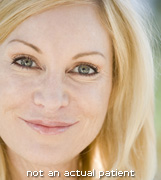Eliminate Imperfections and Improve Skin’s Surface
Laser Resurfacing Scottsdale, Arizona

As skin ages, volume and elasticity diminish, and textural and pigmentation changes can result in wrinkling, brown spots, and blotchiness. Although skin laxity may be addressed with face lifts or neck lifts, and volume can be improved with injectable treatments or fat transfers, improvement of the skin surface is accomplished with resurfacing procedures. In addition to improving the appearance of age spots and blotchiness, resurfacing procedures reduce scars from either acne or trauma. To learn more about rejuvenating your skin with laser resurfacing, contact Dr. Pamela Henderson at her practice in Scottsdale, Arizona.
The Consultation
Patients interested in laser resurfacing will attend a consultation with Dr. Henderson, during which she will examine the skin to determine the severity of wrinkling and pigmentation change. The types of resurfacing procedures available are discussed, including the potential risks and downtime.
Dr. Henderson currently uses the CO2 laser, the Erbium YAG laser and the fractional CO2 laser. Which laser is used depends on the severity of the skin surface changes, the patient’s skin type, the downtime the patient is willing to accept, and the patient’s expectations for improvement. Generally, patients with fair to light skin are the best candidates for laser resurfacing due to the increased risks of developing a pigmentation abnormality in patients with olive or darker complexions.
Preparing for Surgery
Although patients with fair to light skin have lower risks of pigmentation abnormalities following laser resurfacing, it is not impossible and therefore it is common to begin a regimen of bleaching cream and isotretinoin (eg. Retin-A®) six weeks prior to the procedure date to minimize the risk. Patients are scheduled for a preoperative appointment approximately two weeks prior to the procedure date. During that appointment, additional preoperative instructions are given and consent forms are reviewed. Perioperative treatment with an antiviral is recommended in patients with a known or possible history of cold sores.
Anesthesia
In most cases, laser resurfacing is performed as an outpatient procedure, using IV sedation often referred to as “twilight anesthesia.” In some cases where a light fractional CO2 laser treatment is performed, local or topical anesthesia can be used, and may be combined with an oral or intramuscular medication for relaxation. For either local or IV sedation procedures, laser resurfacing is performed at Dr. Henderson’s Scottsdale, Arizona practice, in the accredited in-office surgical suite.
The Laser Resurfacing Procedure
The choice of laser utilized is determined by factors including the severity of the wrinkles and skin blotchiness combined with the patient’s expectations and the acceptable amount of downtime. Generally, the downtime and effectiveness is in direct relationship to the depth of treatment. The fractional CO2 laser is most often used in patients with mild to moderate degrees of wrinkling since more aggressive treatment is unnecessary and only increases risks and downtime. The CO2 laser is appropriate for patients with more severe wrinkling who are also looking for some degree of skin tightening. The erbium laser is slightly less aggressive than CO2 with a slightly faster recovery and can be used on patients with light to more severe wrinkling. It is essential to remember, however, that any laser can be used lightly or more deeply, and it is not just the laser that is chosen that determines the results but the technique that is utilized.
After Surgery
Following the laser resurfacing procedure, patients will experience anything from a period of exfoliation with very light treatment to a period of rawness which can last for a few days to a couple of weeks depending on the depth of treatment. During this time, weeping of the skin with a yellowish exudate may occur, and can be treated with cool compresses and a topical moisturizing lubricant.
As the new skin grows, the weeping diminishes and the skin will appear pink. This pinkness can persist for weeks to months depending on the technique used and the depth of treatment. During this time, the skin is fragile and should be protected from sun exposure with a good sunblock. It is not uncommon during the healing stages to experience itching that can be relieved with a topical product or with oral antihistamines. Generally, approximately six weeks after the procedure, bleaching creams are resumed to inhibit blotchy pigmentation until the pinkness has resolved. Patients often see continued improvement in the texture of the skin as new collagen formation occurs over the first few months.
Risks
Although uncommon in association with laser resurfacing procedures, complications can occur. These include but are not limited to infection (bacterial or viral), scarring, hypopigmentation (loss of pigment), and hyperpigmentation.
Learn More about Laser Resurfacing
Eliminate age spots, blotchiness, and scars with effective, rejuvenating laser resurfacing. To schedule a consultation, contact Dr. Henderson at her Scottsdale, Arizona practice, where she proudly serves patients from throughout the greater Phoenix area.

